MTF Micomp: Procurement Chain Integration Using a Sell-Side Solution
MTF Micomp AG is part of one of the leading system resellers in Switzerland. In addition to implementing and maintaining end-to-end IT solutions, the company also offers a wide range of IT products. To ensure that corporate customers can procure these standard products as efficiently as possible, MTF Micomp uses an electronic sell-side solution developed by io-market. This allows full integration of all systems – from the distributor to the end customer – which optimizes business processes and reduces the manual effort required to process orders. Customer needs were a central consideration when implementing the solution. In addition to the efficient ordering functions offered by the e-commerce platform, MTF Micomp's employees have more time to properly advise customers on complex projects.
Inhaltsverzeichnis
1. The Company2. What Triggered the Project
3. Procurement Chain Integration Using a Sell-Side Solution
Business Perspective, Integration , Process Perspective , Sell-Side, E-Shop, Procurement, Application Perspective, Catalog Management , Technical Perspective
4. Project Processing and Operations
Partner Selection
5. Experiences
6. Success Factors
1. The Company
Background, Industry, Product, and Target Group
Micomp AG was founded in 1982 in Triesen, Liechtenstein, and currently employs around 25 people at its locations in Triesen, Chur, and Davos. In 1992, the company decided to join the MTF Group, one of the largest system resellers in Switzerland. The main benefits of the merger between MTF and Micomp are reflected in purchasing conditions, common market approach, safeguarding of cross-regional service, and knowledge transfer within the Group. At the same time, each member of the MTF Group remains independent and has a broad scope to act autonomously.
The MTF Group has eight members, employs 280 staff at 14 locations, and achieved a total sales volume of CHF 145 million in 2005. The company's core business activities involve providing end-to-end IT services from a single source for configuring and operating customized IT infrastructures. In addition to this, the MTF Group offers customers in Switzerland and Liechtenstein a variety of over 18,000 mostly standardized IT products from leading manufacturers. These range from printer accessories and servers to complex storage systems.
The industry is characterized by a saturated market and stiff competition. Alongside a significant drop in prices, the percentage decrease in margins is also hitting companies hard. For this reason, MTF Micomp pursues a differentiation strategy that aims to achieve a high rate of customer retention thanks to outstanding service.
While private customers can also procure IT products from MTF, the company's main target group comprises small and medium-sized corporate customers. As a result, the companies supplied by the MTF Group vary widely in terms of type and size – from one-man operations to international corporations.
Corporate Vision
MTF's corporate vision is based on confidence in qualitative IT services, which are achieved by means of effective collaboration with business partners as well as professionalism, know-how, and continuity. All of MTF's corporate activities are tailored to the needs of customers. In line with the vision of "IT on tap", MTF's customers should not have to think about IT, but should instead be free to concentrate fully on their own business. The MTF brochure states that:
"You can get water from the tap whenever you want, and you trust that it's clean and safe without having to think about the complex infrastructure of water supply yourself. Why should IT be any different?" (Principle of the MTF Group)
This comparison to water supply also holds true at MTF Micomp in the area of e-procurement, where the aim is to implement fully electronic procurement processes that extend from purchase order (PO) placement to invoice posting. The solution presented here has allowed significant steps to be made towards achieving this goal.
Importance of IT and E-Business
The importance of IT and e-business at MTF Micomp must be considered from two different perspectives. On the one hand, the company is active in the area of IT with the sale of IT products, services, and system solutions, and on the other hand it uses new technologies to support internal and cross-company processes. IT and e-business are, therefore, of the utmost importance to MTF Micomp.
In the medium term, MTF Micomp aims to achieve 10-15% of its total sales volume from electronic channels. In a consulting-oriented environment in which contact with the customer is of central importance, the sale of standardized IT products is merely a secondary business area. As more and more large companies switch to integrated procurement solutions and electronic invoicing, it should be possible to achieve more than 10-15% of sales from online business.
2. What Triggered the Project
Initial Situation and Trigger for the Project
Before the solution presented here was introduced, the system landscapes of distributors, customers, and MTF Micomp were not fully integrated. What is more, MTF Micomp had neither an e-shop (e-commerce) in which to sell its products nor the possibility to submit electronic purchase orders to its own suppliers (e-procurement). When purchase orders were placed by telephone or fax, it was necessary to ask the distributors manually for a suitable offer in terms of availability and price, compare the offers, calculate prices for each scenario, and trigger the purchase order at the most suitable distributor. Depending on the scope of the purchase order, this could be very labor-intensive.
The trigger for the project presented here was the aim of minimizing the manual administrative processes for ordering standard products and freeing up more time for advising customers. Due to the market situation, MTF Micomp was (and still is) forced to take full advantage of all streamlining potential. Modern information and communications technologies are helping the company to optimize workflows and coordinate processes that involve several departments or companies.
Our Business Partners
The main business partners of MTF Micomp are the other companies of the MTF Group as well as distributors and corporate customers. The most important partner in the implementation and operation of the solution presented here is io-market AG, which is introduced below:
io-market is a young, innovative IT service provider that was founded in June 2000 in Triesen, Liechtenstein. The company's core competencies are the development of interface solutions and business software for all aspects of the procurement process. The io-network operated by io-market comprises over 2,500 customers who are integrated actively in various business processes. The io-network is, therefore, the central platform to which the customer IT systems are connected to enable them to exchange data and documents efficiently with their business partners. The io-network is part of the io-procurement solution, which comprises modules for managing orders, catalogs, shops, VMIs, requests for offers, and EBPP.
3. Procurement Chain Integration Using a Sell-Side Solution
In the following sections, the solution is considered from a business, process, application, and technical perspective. The descriptions focus on the workflows for ordering standard products. The consulting and service business, which forms a large part of MTF Micomp's activities, is not discussed here.
Business Perspective
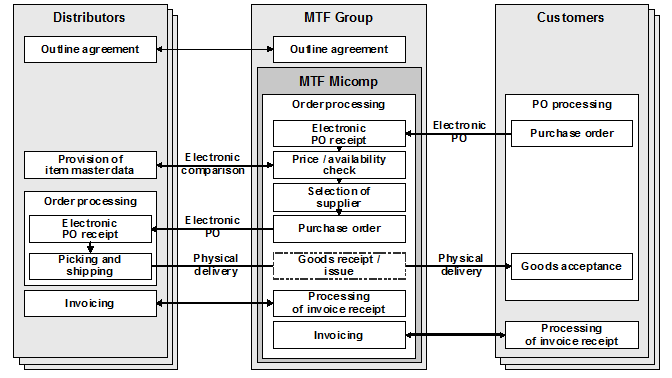
Fig. 1: Business Scenario: Order Processing at MTF Micomp
As part of the MTF Group, MTF Micomp is central to the business perspective (Fig. 1). IT products are traded based on outline agreements with distributors, which are concluded at MTF Group level to ensure better conditions. MTF Micomp's relationships with customers are not based on outline agreements, but instead on outstanding service, mutual trust, and effective long-term collaboration. Fig. 1 shows the interplay between the MTF Group, MTF Micomp, and distributors and customers, and outlines the key processes [Integration]. The new solution has had only a minimal effect on the business relationship between the partners involved. The end-to-end electronic process support has, however, reduced the lead time and the manual effort required to process purchase orders. From the customer's point of view, the new solution offers the option of placing product orders using the e-commerce platform in addition to the existing options of placing orders by telephone or in writing. As soon as the purchase order has been entered in the MTF Micomp system (either directly (electronically) or manually if the purchase order was placed by telephone or fax), the system can now identify the best offers automatically by comparing the item data and trigger the purchase order at the relevant distributor. Electronic support for the invoicing processes is already ensured from a technical perspective and will be introduced in the near future.
Process Perspective
While Fig. 1 shows the points at which integration is achieved through electronic support for the business processes, the process perspective focuses on two workflows that have been greatly simplified by the introduction of the solution. These are the process for importing the current item master data using the io-network (Fig. 2) and the ordering process for customers using the new sell-side solution (Fig. 3).
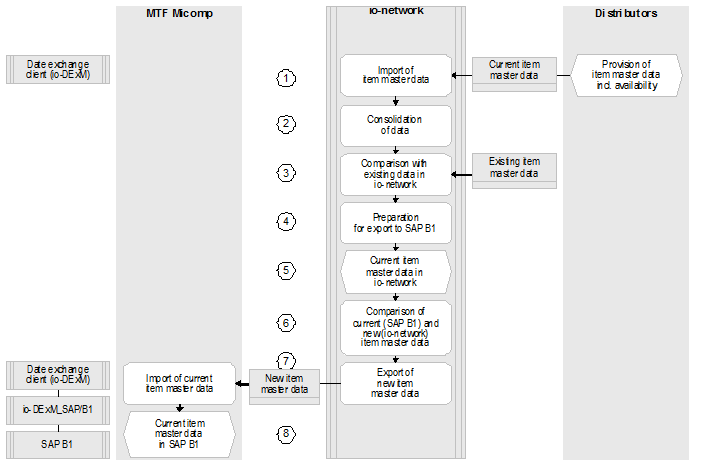
Fig. 2: Import of the Current Item Master Data Using the io-network
When the item master data is transferred automatically from the distributor systems (Fig. 2), the data is merged (2), stored centrally in the io-network (1 to 7), and compared (7) with that in the ERP system at MTF Micomp. The solution was designed to ensure that the dataset is up to date with as little data transfer as possible. This means that during synchronization, data is only transferred if it has actually changed since the last update. Note that all processes (data import from the distributor systems, comparison with existing data, and formatting and provision of the data) take place automatically within the io-network (1 to 7). The way in which the data is merged and standardized is mainly defined using the rule assistant. Once these settings have been made, the relevant process starts automatically early in the morning. The information about which data is currently stored in the ERP system (SAP Business One) is already stored in the io-network. This means that in Step 6 (Fig. 2), the comparison can be carried out without data being exchanged between MTF Micomp and the io-network. Step 7 is started automatically so that the new item master data is transferred to the ERP system (8). The central data repository is the io-network database, which also provides the data for the e-commerce platform.
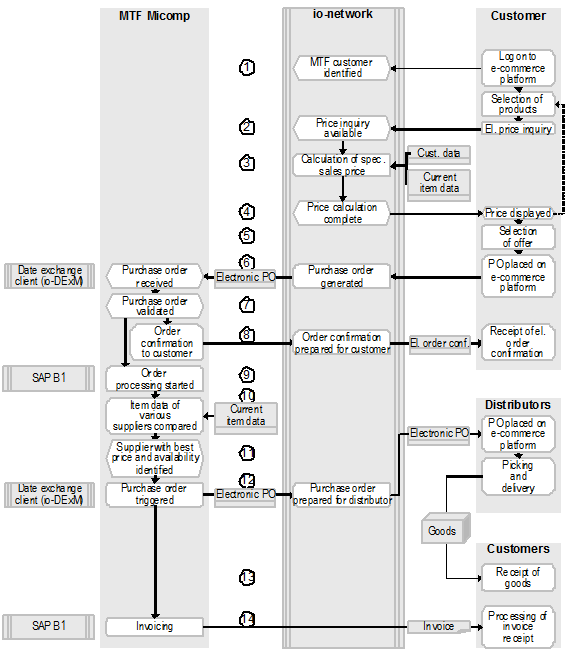
Fig. 3: Ordering Process and Workflows from the Perspective of MTF Micomp
Fig. 3 shows the ordering process [Procurement] for customers using the new e-commerce platform [E-Shop]and the integrated processes for order processing at MTF Micomp and io-market. At the start of the ordering process (1), the customer logs on to access his personalized area of the e-commerce platform. Here he can search the entire product range and view product details. When a customer opens the detail view, a price inquiry is sent to the server automatically (2). The calculation of the sales price for the customer who is currently logged on is started based on the customer data (such as conditions agreed upon and customer value) and on the current item data (3). The pricing model takes account of discounts, net or gross profit margins, and special and customer-specific prices. The price models are combined such that the best possible offer is shown to the customer. The newly calculated, customer-specific sales price is shown together with the detail view of the product.
Once the customer has placed a purchase order (6), this is imported into the ERP system at MTF Micomp using the io-network and the data exchange client (io-DExM). Once the purchase order has been validated (7), the order confirmation with the sales prices calculated in Step 3 is sent to the customer electronically (8). Order processing is also started by an employee at this point (9).
Based on the current item data (price, availability), the system selects the distributor who offers the optimum combination of purchasing price and availability (10, 11) and triggers the purchase order (12). The purchase order is also forwarded automatically to the distributor if his processes are integrated sufficiently. The goods are normally delivered by the distributor to the customer in the name of MTF Micomp (13). The invoicing process for issuing the invoice to the customer is then started in the ERP system (14). This is currently still done on paper.
Note the high level of automation that the solution has made possible from the process perspective. Most manual activities, such as checking prices and availability (see "Initial Situation and Trigger for the Project"), are now carried out by the system.
Application Perspective
The fact that the manual processes for order processing at MTF Micomp have been replaced and are now supported electronically has already been mentioned several times. Fig. 4 shows the applications that the solution presented here facilitates.
Most activities at MTF Micomp are carried out using the SAP Business One ERP system that is implemented throughout the MTF Group. The ERP system is integrated with the io-network using custom-developed io-network connectors (io-DExM_SAP/B1) that connect the io-network with the ERP system by means of the SAP DI server (not shown in the figure). This connection to the io-network is used to exchange all of the data for master data maintenance and order processing. As soon as electronic invoicing has been launched, invoicing data will also be exchanged using this channel. MTF Micomp uses a Web browser to access the modules of the io-network directly (for example, to manage the sell-side solution or change the settings in the rule assistant).
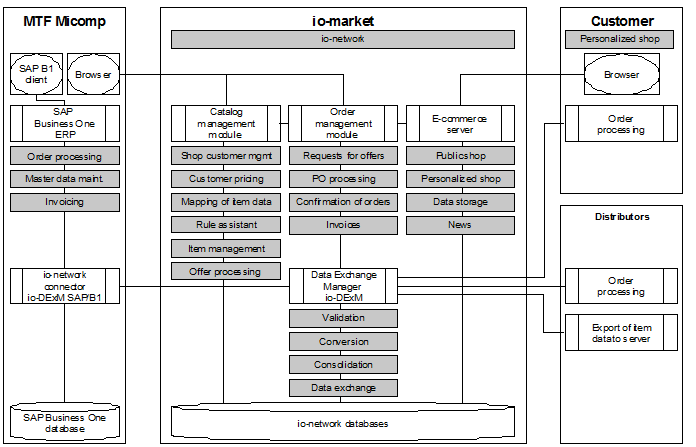
Fig. 4: Application Perspective
At the center of Fig. 4 is the io-network, which io-market hosts and operates for the network partners as an ASP solution. ASP stands for "Application Service Provider" and denotes computer applications that a service provider makes available over the Internet. The Data Exchange Manager (io-DExM) is the central interface for data communication with the io-network. In addition to validating, converting, and consolidating the data, the io-DExM is used primarily for exchanging data both within and outside of the io-network.
The e-commerce server in the io-network is used to interact with customers. Customers can log on to the server using a browser and place purchase orders in their personalized e-shop. Since customers can also view documents such as their specific maintenance contracts in their personalized area of the server, the e-commerce server also functions as a data repository. A public variant of the e-shop is available for (mostly private) customers who have not registered and cannot, therefore, log on.
Once the purchase order has been sent, the data is transferred to the order management module of the io-network, where it is prepared for communication (interface, fax, e-mail, and so on) and transferred depending on the type of integration. If an order confirmation is then issued for this purchase order (generated in SAP Business One), this is imported to the order management module of the io-network, validated against the purchase order, and transferred to the distributor depending on the type of integration. This will also apply to invoices in the future. The order management module also serves as a control system for orderers and suppliers and as an archive.
The catalog management module is used to administrate the sell-side solution and comprises modules for managing shop customers, defining customer-specific price calculations, providing information for mapping the item data, the rule assistants mentioned above, all item management, and offer processing. Depending on customer requirements, the ordering process can be adjusted to include defined workflows such as account assignment before the purchase order is sent.
Customers use a Web browser to access the sell-side solution and place purchase orders. Corporate customers also have the option of connecting order processing in the ERP system with the io-network in such a way that when a purchase order is placed, their own order processing functions are triggered and the order number is sent to MTF Micomp along with an approval. The electronic order confirmation is then sent in the same way but in the opposite direction.
The distributors are also connected to the io-network at two points. They are connected so that they can provide the item master data for transfer to the io-network database, and also within the scope of order processing. Distributers' order processing functions are integrated so that purchase orders can be transferred directly and seamlessly.
Technical Perspective
Fig. 5 shows MTF Micomp, io-market, and the partners involved from a technical perspective. Note how few requirements exist for the system landscape at MTF Micomp, its customers, and its distributors. Most parts of the systems that are required to operate the solution are hosted and operated by io-market.
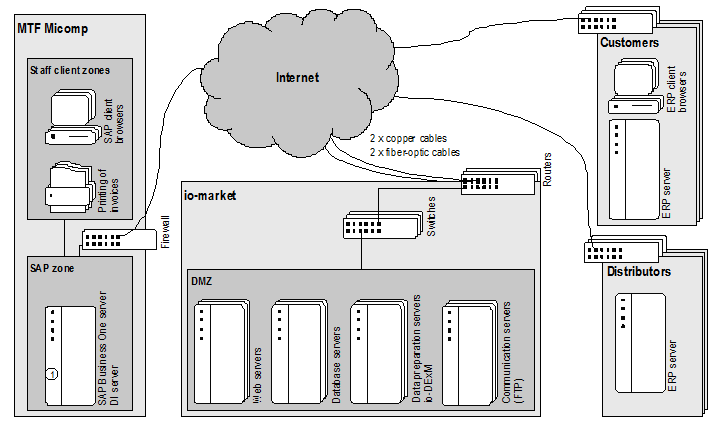
Fig. 5: Technical Perspective
Tab. 1 shows the specifications of the SAP Business One server at MTF Micomp, on which the SAP DI server, which is used for communication with the io-network, also runs. As shown in Fig. 4, standard PCs and Web browsers are used to access the io-network directly.

Table 1: Specifications and Characteristics
4. Project Processing and Operations
Project and Change Management
When the first discussions between MTF Micomp and io-market took place in August 2004, MTF Micomp had already clearly defined its objectives. It was looking for a partner who could fulfill the requirements defined and operate the new application as an ASP solution.
The first version of the new e-commerce platform was planned for November 2004, but had to be postponed until February 2005. The main reason for the delay was the decision to base the new MTF solution on the latest release of the io-network, which had not yet been completed at the time. Numerous improvements and adjustments have since been made, such as the new development of the complex, dynamic pricing system and the rule assistant.
Since the project affected internal workflows and interaction with customers, it was very important to take account of the needs of the persons involved. Workshops were held with several key B2B customers to ensure from the outset that the application was geared towards the needs of customers. To allay potential reservations among employees, the project was given broad support and the intention to deploy the freed-up capacity in the area of customer care was communicated clearly.
[Patner Selection] The IT partner was selected based on existing expertise in the area of configuring and maintaining integrated e-commerce platforms. io-market was able to prove based on previous projects that it was in a position to meet the project objectives and to configure operation of the solution in the io-network within a reasonable period of time. Physical proximity was not a factor in the decision to award the project, even though this proved beneficial in hindsight.
Development and Rollout of the Software Solution
The application is based on the io-network that has been developed by io-market since the year 2000. Many functions were already available in the io-network and could be used for the MTF solution. Adjustments were necessary in particular for transferring distributor data and integrating the dynamic pricing model. Thanks to the modular structure of the io-network, these changes and enhancements could be made without serious difficulties. Even though a network such as the io-network offers numerous benefits, not only in relation to economies of scale, adjustments must be made carefully to ensure that the operations of the productive modules are not impaired.
Continuous Maintenance
The io-network, and with it the entire e-commerce platform, is operated as an ASP solution. This means that io-market is responsible for hardware and software maintenance. Alignments and necessary adjustments are discussed by MTF Micomp and io-market and then implemented by io-market once a corresponding order has been issued.
5. Experiences
User Acceptance
Acceptance among regular users is very high. Once the users – mainly the purchasers and IT employees of commercial customers – had been introduced to the new solution, the reaction was consistently positive. Experience has shown, however, that launching a sell-side solution does not in itself encourage users to adopt this method for placing purchase orders. The reluctance to switch from placing purchase orders by fax to placing them using the e-commerce platform was initially underestimated.
Achievement of Goals and Changes Brought About
When the project was launched in August 2004, no integrated sell-side solutions were in operation within the MTF Group. MTF Micomp in Triesen set itself the goal of rolling out a solution that was tailored to customer requirements and also integrated distributor and customer systems. Today it is clear that the goals that MTF Micomp set itself back then have been achieved. This includes functions such as the dynamic pricing model, which was deemed complex from the outset.
In addition to the aspects already described, greater customer focus prevails today at MTF Micomp, coupled with a higher degree of customer satisfaction. By rolling out the new solution, MTF Micomp has shown that it sets great store by optimizing processes both within the company and in conjunction with its business partners.
Investments, Profitability, and Key Figures
From the very start of the project, it was apparent that the ROI would not be positive for at least three years. Nevertheless, a decision was made to roll out the solution as soon as possible, since all parties were convinced of its future benefits. It is difficult to delimit the key figures and benefits of the project at MFT Micomp since several other changes that incurred costs were made at the same time (such as the rollout of SAP Business One). It was deemed that these would have a positive effect at process level in the future. MTF Micomp emphasizes, however, that knowing what it knows now, it would still implement the sell-side solution to the same extent and with the same partners.
6. Success Factors
The main success factors of the solution are integration and automation. Integration involved integrating distributors and corporate customers electronically using the io-network as the central platform. Automation is the result of this integration, since the data must be standardized and cleansed before the processes can be executed automatically.
The outstanding special features of the solution are central data storage at io-market, the resulting benefits to MTF Micomp (ASP operations), the simple, targeted structure of the e-commerce platform (from a user perspective), the development of the dynamic pricing model, and the simplified connection of the customers and distributors of MTF Micomp. The personalized e-commerce platform (customer-specific product range), information about contracts between the customer and MTF Micomp, and the customer-specific prices offer significant added value to the vast majority of corporate customers. This allows standard products to be sold and procured more efficiently.
Reflection of "Process Excellence"
The excellence of the processes of this solution lies in the high level of automation and the option of integrating the systems fully from the corporate customer to the distributor. This means that the system can carry out many activities that used to be performed manually by the partners involved. The solution reduces the effort required to procure standard products to an absolute minimum, therefore.
Lessons Learned
A key experience that MTF Micomp has gained from the implementation of this solution has less to do with implementation than with customer acceptance. It is still difficult to discourage corporate customers from using traditional ordering processes such as fax and telephone and to convince them of the benefits of electronic ordering. It is not enough to provide an e-commerce platform like the one presented here without familiarizing the target user group with the new functions. It is expected that the increasing pressure to save process costs and the launch of electronic invoicing will encourage more customers to use the sell-side solution. MTF Micomp expects that the solution will increase customer retention and create competitive advantages. This will allow it to provide customers with proactive support to optimize their processes.




